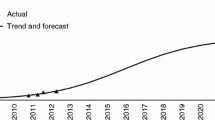Abstract
The needs of the elderly in many product and service areas are clearly different from those of the rest of the population. These needs could be fulfilled at a profit if marketers responded in adequate measure. The authors present evidence that marketers have made some progress in this direction, but much more is needed. The authors present various actions in terms of product, price, place, promotion, and packaging that marketers can implement in order to meet the neglected needs of the elderly. These actions not only contribute to the welfare of the elderly, but they are likely to be profitable for the marketers as well. Finally, the authors identify some important issues in public policy that relate to the elderly.
Similar content being viewed by others
References
Advertising Age, 1980. “Special Section, on the Maturity Market,” (August 25) S1–S2.
Allan, Carole B. 1981. “Measuring Mature Markets.”American Demographics 3 (March) 13–17.
Annand, Mary. 1975. “Banking Made Easy—for the Elderly.”Burroughs Clearing House 59 (February) 26–27.
Atchley, Robert C. 1972.The Social Forces in Later Life: An Introduction, to Social Gerontology. Belmont, CA: Wadsworth.
Barak, Benny and Leon G. Schiffman. 1980. “Cognitive Age: A Non-Chronological Variable.”Advances in Consumer Research 8, 602–606.
Bartos, Rena. 1980. “Over 49: The Invisible Consumer Market.”Harvard Business Review 58 (January–February) 140–148.
Bernhardt, Kenneth L. and Thomas C. Kinnear. 1975. “Profiling the Senior Citizen Market.”Advances in Consumer Research 3, 449–452.
Berry, Leonard L. 1972. “Marketing Challenges in the Age of the People.”MSU Business Topics (Winter) 5–12.
Block, Joyanne E. 1974. “The Aged Consumer and the Market Place: A Critical Review,”Marquette Business Review 18 (Summer) 73–81.
Bucklin, L. 1969. “Consumer Search, Role Enactment, and Market Efficiency.”Journal of Business 42 (October) 416–438.
Bureau of Labor Statistics. 1978.Consumer Expenditure Survey: Integrated Diary and Interview Survey Data, 1972–73, Total Expenditures and Income for the U.S. and Selected Areas.Bulletin No. 1992. Washington, D.C.: U.S. Department of Labor.
Chen, Yung-Ping. 1981. “Keynote, Address.”Report of the White House Conference on Aging. Kansas City, MO: First annual Conference on the Economics of Aging (April 3–5).
Edwards, Mark Robert. 1979. “The Effects of Decision, Complexity. Information Load and Age on Consumer Decision Accuracy.” Unpublished doctoral dissertation. Arizona State University.
Engel, James F., Roger D. Blackwell and David T. Kollat. 1978.Consumer Behavior. Hinsdale, IL: Dryden Press, Third Edition.
Gelb, Betsy D. 1978. “Exploring the Gray Market Segment.”MSU Business Topics 26 (Spring) 41–46.
Harris, Charles S. 1978.Fact Book on, Aging: A Profile of America's Older Population. Washington, D.C.: National Council on Aging.
Howell, J. and D. Loeb. 1975. “Incone, Age and Food Consumption.”Gerontologist 15 (February) 7–16.
Johnson, Robert F. 1975. “Clothing Fires Involving Seniors.”Proceedings. St. Paul. MN: Conference on Realities of Aging.
Kirkeby, Marc. 1980. “The Maturity Market is Coming of Age.”Advertising Age (August 25) S1, S10
Lambert, Zarrel V. 1979. “An Investigation of Older Consumers' Unmet Needs and Wants at the Retail Level.”Journal, of Retailing 55 (Winter) 35–57.
Martin, Claude R., Jr. 1975. “A Trans-Generational Comparison: The Elderly Fashion Consumer.”Advances in Consumer Research 3, 453–456.
Mason, Marry J. and William O. Bearden. 1979. “Satisfaction/Dissatisfaction with Food Shopping Among Elderly Consumers.”The Journal of Consumer Affairs 13 (Winter) 359–369.
McCann, John. 1974. “Market Segment Response to the Marketing Decision Variables.”Journal of Marketing Research 11 (November) 399–412.
Moroz, Paul. 1979. “Discovering the Over-50 Set.”Business Week (November 19) 194–195
Phillips, L. and B. Sternthal. 1977. “Age Differences in Information Processing: A Perspective on the Aged Consumer.”Journal of Marketing Research 14 (November) 444–457.
Pieper, Alicia U. 1968. “Survey of Clothing Needs of Women 65 and Older.” Unpublished master's thesis, Kent State University.
Reincke, John A. 1976. “Expenditures of the Two-Person Units and Individuals After Age 55.” Frederick E. Waddell, ed.,The Elderly Consumer. Columbia, MD: Antioch College Press, 83–107.
Rose, Arnold M. and Warren A. Peterson. 1965.Older People and Their Social World. Philadelphia, PA: F.A. Davis.
Sales and Marketing Management Marketgraph. 1979.Sales and Marketing Management 123 (October 29) 31.
Schiffman, Leon. 1971. “Sources of Information for the Elderly.”Journal of Advertising Research 11 (October) 33–37.
Schutz, Howard G., Pamela G. Baird and Glenn R. Hawkes. 1979.Lifestyles and Consumer Behavior of Older Americans. New York: Praeger Publishers.
Silvenis, Scott. 1979. “Packaging for the Elderly.”Modern Packaging 52 (October) 38–39
Simmons Media Studies. 1980. “Selective Markets and the Media Reaching Them.” New York: Simmons.
Smathers, Diana. 1974. “The Effects of Physical Bodily Changes Caused by the Natural Aging Process on Clothing, Preferences of Elderly Women.” Unpublished master's thesis, University of Kentucky.
Towle, Jeffrey G. and Claude R. Martin, Jr. 1975. “The Elderly Consumer: One Segment or Many?”Advances in Consumer Research 3, 463–467.
U.S. Bureau of the Census. 1976. “Demographic Aspects of Aging and the Older Population in the U.S.”Current Population Reports, Series P-23, No. 59, Special Studies. GPO. Washington, D.C. (May) 4–9.
U.S. Bureau of the Census. 1979. “Social and Economic Characteristics of the Older Population, 1978.”Current Population Reports Series P-23, No. 85. GPO. Washington, D.C. (August) 33
U.S. Bureau of the Census. 1980. “Money Income of Families and Persons in the U.S.: 1978.”Current Population Reports, Series P-60, No. 123. GPO. Washington, D.C. (June) 185, 207.
Waddell, Frederick E. 1975. “Consumer Research and Programs for the Elderly: The Forgotten Dimension.”The Journal of Consumer Affairs 9 (Winter) 164–175.
Weinrobe, Maurice D. 1981., “Renegotiable Reverse Mortgage.”Report of the White House Conference on Aging. Kansas City, MO: First Annual Conference on the Economics of Aging (April 3–5).
Yep, Jacquelyn. 1977Textiles and Clothing. Ames, IA: Iowa State University Press.
Zbytniewski, Jo-Ann. 1979. “The Older Shopper: Over, 65 and Overlooked?”Progressive Grocer 58 (November) 109–111.
Author information
Authors and Affiliations
Rights and permissions
About this article
Cite this article
Visvabharathy, G., Rink, D.R. The elderly:Still the “invisible and forgotten” market segment. JAMS 13, 81–100 (1985). https://doi.org/10.1007/BF02737201
Issue Date:
DOI: https://doi.org/10.1007/BF02737201



